Table 2.1.

by
Thomas Michael Power, Ph.D.
Professor
of Economics, University of Montana
Chapter 2
National
Forest Timber Harvests and Local Economic Well-Being in Washington: What
the Data from the 1990's Decline in Federal Harvests Tells Us
Synopsis
This chapter analyzes the economic impacts of the large declines in National Forest timber harvests since the late 1980s; that experience represents an impact that was many times larger than the impact that can be expected from setting all inventoried roadless areas off limits to commercial timber harvests. See Table 2.1. If the impacts of such a dramatic fall down in federal timber harvests during the 1990s were successfully dealt with by Washington's communities, we can be certain that they will have no significant problems coping with the timber harvest implications of protecting all of Washington's remaining roadless areas.
The following impacts on eastern and southwest Washington counties can be summarized when federal timber harvests declined by 90 percent between 1988 and 1998 in this way:
a. Statewide, the number employed outside of the forest products sector expanded by 726,000, despite the loss of 7,300 forest products jobs. Total real income expanded by almost 50 percent, population by 23 percent and total employed persons by 33 percent between 1988 and 1998.A. Introductionb. Similar economic vitality was also found in the largely nonmetropolitan counties adjacent to National Forest lands in eastern and southwestern Washington. Despite the loss of several thousand forest products jobs, nearly 170,000 newjobs were added outside that sector. The counties adjacent to the National Forests were not driven into economic decline, instead, average real income, employment, and population expanded significantly.
c. Even within the relatively isolated areas such as the northeastern tier of counties there was considerable economic vitality. Only two isolated "timber dependent" towns lost population. In general, all areas gained population at rates above the national average. Some of the isolated areas, such as Okanogan County, did almost as well as the state's metropolitan areas.
d. The relatively high unemployment rates in many of the eastern and southwestern Washington counties adjacent to National Forests cannot be attributed to the decline in federal harvests. Those counties had similar excess unemployment rates at the time of peak harvests in the late 1980s when timber supply constraints were obviously not limiting harvests. These excess unemployment rates did not rise as federal harvests fell dramatically from these peak levels.
e. The average real pay is low in eastern and southwestern Washington counties adjacent to National Forests. This low pay, however, is not the result of the decline in federal harvests. Average real pay plunged during the 1980s while federal harvests were rising to peak levels. While federal harvests fell in the 1990s, average pay stabilized or increased.
f. National Forest payments to local governments declined with federal harvests during the 1990s. This, however, did not cause an overall decline in the revenues available to local governments. Local and state economic vitality allowed local government revenues to double in the 1990's despite the reduction of the National Forest contributions.
One does not have to rely on speculation about the likely impact on Washington's communities from reductions in National Forest timber harvests. Since the late 1980s National Forest timber harvests have plunged dramatically across Washington. The 1990s were a decade-long period of economic adjustment to these much lower federal harvests. This experience provides an economic laboratory of sorts to analyze the ways in which changes in National Forest timber harvests affected communities in eastern and southwest Washington.
This is not to suggest that protecting Washington's remaining roadless areas would have an impact on National Forest timber harvests of a size similar to what the state has already been through. It most definitely would not. First, since National Forest timber havests have fallen to a small fraction of what they once were, one-tenth to one-third, even if all of the remaining federal harvest was lost, the impact would be much smaller than what the state has already experienced. Second, most of the remaining roadless areas are not part of the National Forest's commercial timber base. Significant harvests are not planned in these roadless areas. During the 1990s very little timber flowed from the National Forest roadless areas of eastern and southwestern Washington. In addition, only quite low or zero timber harvests are planned from these areas in the foreseeable future. In short, National Forest timber harvests, in general, are not tied to these areas. This means that whatever management rules govern these lands, be it the continuation of current Forest Service plans, Wilderness designation, or restrictions on road building flowing from the Clinton Administration's Roadless Area Initiative, the impact on National Forest timber harvests will be quite small compared to the declines with which Washington has already had to cope.
The projected declines over the next five years or so will only be 0.2 percent to 6.3 percent of the impacts that Washington communities have already digested. See Table 2.1 for a summary of these short-term impacts. As will be discussed more fully in Chapter 5, the long-term impacts may be larger than this, but even if they are several times larger, the impacts will still be quite small relative to the declines in National Forest harvests with which Washington communities have already had to cope. Meanwhile, the very small impacts of protecting the remaining roadless areas should be kept in mind as this chapter explores the impacts of the much, much larger declines in National Forest harvests that took place during the 1990s.
B. Washington State and Regional Economic Vitality
As a first broad brush overview of how Washington and its communities have coped with dramatic declines in National Forest timber harvests, consider the state as a whole and three broad economic regions in the state: southwest, central, and eastern Washington. Following this overview, in the next sections, the study will focus on individual counties and isolated towns.
Table 2.1.

The declines in National Forest timber harvests in Washington have been dramatic. If we average over two five year periods to avoid measuring between untypical years, the declines between the 1986-1990 average and the 1994-1998 average were 87 percent for the state as a whole, 89 percent for the southwest corner of the state, 81 percent for the central counties, and 68 percent for the 11 eastern-most counties. The bulk of the National Forest harvests that was available in the second half of the 1980s was no longer available in the second half of the 1990s.
Given the familiar twin assumptions that forest products are a key element in the economic base of many counties outside of the Puget Sound area and that National Forests are an indispensable source of raw material, one might expect this dramatic fall down in federal timber supply to have had a crippling effect on the economic vitality of the state and the sub-state regions that significantly depend on the forest products industry. At the statewide and broad regional basis, no such effects are evident. As federal timber harvests plummeted during the 1990s, employment expanded by almost 18 percent statewide. The southwest and eastern counties saw employment grow even faster, by a fifth to a quarter. Total real income received by residents grew even faster, allowing average real income to rise steadily. Population also expanded, with counties outside the Puget Sound area often leading the state. In the southwest counties, where the declines in federal harvests were the greatest, employment, population and income growth were the highest. See Figure 2.1 and Table 2.2.
This regional economic vitality despite dramatic declines in National Forest timber harvests is all the more impressive because it took place despite the decline in employment opportunities in the forest products industry. In the southwest counties, close to 3,000 forest products jobs were lost between 1990 and 1998, yet that area led the state in net new job creation, adding over 42,000 jobs in other sectors. In central Washington almost 500 forest products jobs were lost, but over 24,000 jobs were added in other industries. In the northeast, due to the opening of new facilities, forest products employment actually expanded by several hundred. Even in counties with a very high dependence on forest products for employment and which saw significant job loss in that sector experienced net job creation on a major scale. See Table 2.3. Clearly the decline in federal timber harvests did not cripple either the state economy or its various regional economies. It is possible, however, that the decline in federal timber harvests had localized impacts that were negative and severe. We therefore take a closer look at counties with a high dependence on forest products for employment and income.
Figure 2.1: Economic Vitality and Federal Timber Harvests: State of Washington
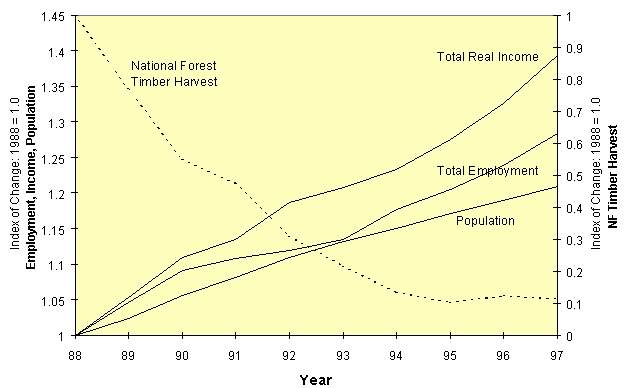
Table 2.2.

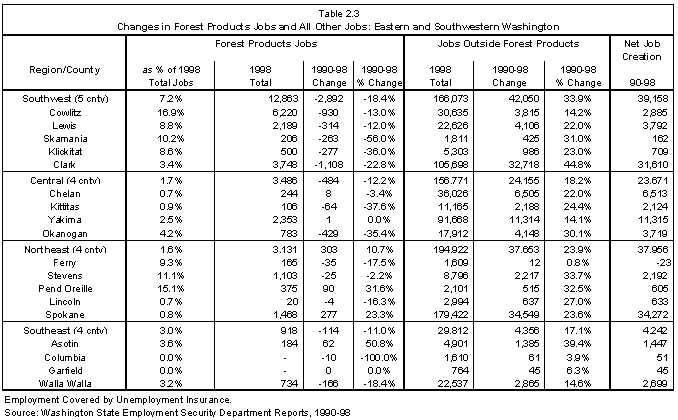
C. Regional and County Impacts of Declining National Forest Harvests (1)
i. Southwestern WashingtonSeveral southwestern Washington counties depended heavily on forest products for employment in 1988 when National Forest timber harvests peaked. Skamania County, whose landscape is dominated by the Gifford Pinchot National Forest and the Columbia River Gorge National Scenic Area, had almost a third of its 2,700 jobs in forest products in 1988. Cowlitz and Klickitat Counties had over a fifth of all their jobs in forest products in 1988. Between the late 1980s and the late 1990s, almost 90 percent of the National Forest timber harvest was lost in these counties. Between 1986 and 1997 Skamania lost 500 of its 700 forest products jobs; Klickitat lost about 300 of its 800 forest products jobs. These job losses in an important sector of the economy certainly had a negative impact on the economies of these counties. Average real incomes in all three of these timber-dependent counties grew slowly, only 2 to 6 percent, while the state as a whole saw average real incomes rise 15 percent during the 1990s. But the economies of these southwestern counties did not simply stagnate as they lost 90 percent of the previous National Forest timber harvest. See Table 2.4. Cowlitz and Lewis Counties added over 7,000 jobs apiece. Klickitat added almost 2,000 new jobs. Clark County, part of the Portland metropolitan area, added over 50,000 jobs.
This increase in jobs helps explain why there was no outmigration from these counties as forest products jobs contracted. Instead there was a significant flow of people into these counties. These five southwest counties saw their populations rise by almost a third, 50 percent faster than the state as a whole. Even Cowlitz, Skamania, and Klickitat had significant population growth. It was actually the movement of people into these counties despite the limited economic opportunities that explain the slow growth in average incomes. Total real income of residents grew by 50 percent for the five counties together, faster than the state as a whole. In Cowlitz, Skamania, and Klickitat real income growth of 20 to 25 percent was balanced by population growth almost as fast, leaving average incomes in 1997 only 2 to 6 percent higher after accounting for inflation. This outcome, however, cannot be described as a stagnating economy. Jobs, total real income, and population all continued to expand vigorously despite the job losses in forest products. See Table 2.4.
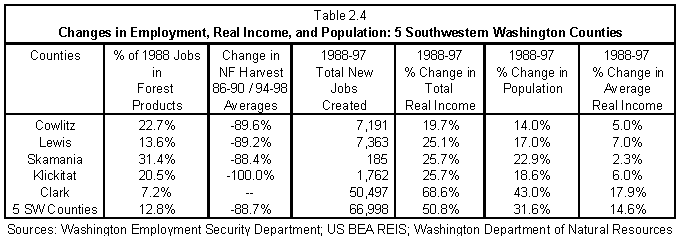
We focus here on the string of counties that stretch along the east slope of the Cascades, from Okanogan to Yakima Counties. This does not really represent a connected regional economy. The southern counties, Kittitas and Yakima, are tied more closely to the Tri Cities area, while Okanogan and Chelan Counties are considerably more isolated, connected weakly to both the Spokane and Puget Sound areas.
ii. Central Washington
Only Okanogan County showed significant dependence on forest products for jobs in 1988 when about 10 percent of covered employment was in that sector. Yakima had 2,300 employed in forest products in 1988 but this metropolitan area had so many other sources of employment that those jobs represented only about 3 percent of total employment. Kittitas and Chelan had 2.4 and 1.7 percent of covered employment in forest products in 1988. Between the late 1980s and late 1990s 60 to 90 percent of the National Forest timber harvests were lost. Okanogan lost 500 of its 1,300 forest products jobs between 1988 and 1998. That job loss, however, was more than made up by expansion in other sectors. On net Okanogan County added almost 5,000 new jobs between 1988 and 1997, ten times the number of forest product jobs lost. (2) Total real income increased by a third, population grew by 16 percent, and average real income increased 14 percent. Clearly the dramatic fall down in National Forest timber harvests and the job losses in forest products in Okanogan County did not lead to a declining or stagnant economy.
For the other
three central Washington counties, there were not dramatic changes in forest
products employment even though federal timber harvests plummeted. Overall,
each of these counties added thousands of new jobs over the last decade.
Total real income also showed significant growth, increasing by about a
third, and all of these counties saw similar percentage increases in population,
about 16 percent. Kittitas County's average real income grew relatively
slowly primarily because of the rapid increase in population, almost 25
percent. The dramatic declines in federal timber harvest did not stifle
the economic vitality of these counties. See Table 2.5.

The three counties in the northeast corner of the state -- Ferry, Stevens, and Pend Oreille -- were among the most timber dependent counties in the state in 1988. At that time about one out of every six jobs were in forest products. Between the late 1980s and the late 1990s National Forest timber harvests fell 60 to 80 percent in these counties. During the same time period Stevens County lost about 260 and Ferry County about 100 forest products jobs. Pend Oreille, although it lost about 50 wood products jobs, gained, on net, 210 forest product jobs as a result of the construction of a new paper mill. Spokane County also added about 150 new forest products jobs. When this group of counties is looked at together, there was almost no change in forest products employment despite the loss of 70 percent of the federal timber harvest.
iii. Northeast Washington
Because of the geography of these counties, with relatively isolated towns such as Colville and Republic that are not actually within commuting distance of the Spokane urban area, the losses in the northern towns cannot be seen as being offset by jobs gains in the southern portions of these counties and region. Nonetheless, the employment gains in these counties were impressive. Stevens County added almost 4,000 new jobs while Pend Oreille added over 1,100. Even Ferry County added 600 net new jobs despite the loss of 100 forest products jobs. All three of the northern tier counties saw significant population growth: Stevens and Pend Oreille had growth of about 30 percent. Ferry, the most isolated of the counties, saw its population rise 21 percent. The large population increase in Stevens County nearly matched its growth in real income, resulting in relatively slow growing average real income. The three northeastern tier counties saw population increases greater than that of the state as a whole.
For the five-county
region as a whole, almost 60,000 new jobs were created, total real income
grew by a third, population expanded 16 percent, and average real incomes
rose 14 percent. Clearly this "timber dependent region" was also not stagnating
due to the loss of 70 percent of the National Forest timber harvest. See
Table 2.6.
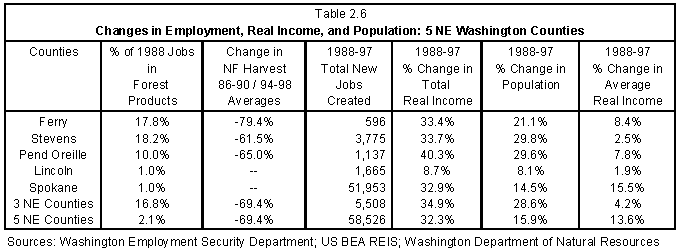
The counties in the southeastern corner of the state are moderately dependent on forest products for employment and income. The four-county area along the southeastern border with Oregon has about 4 percent of total jobs in forest products. Although Walla Walla has very little National Forest land, it does have forest products facilities that employed about 900 workers in 1988. After 1988, Walla Walla lost about 200 of these jobs as timber harvest from the Umatilla National Forest in Washington fell by 60 percent. But Walla Walla created many times that number of jobs in other sectors. Overall employment grew by 5,100. Total real income grew by 19 percent, population increased by 13 percent and real average income rose 6 percent.
iv. Southeast Washington
Asotin County's link with forest products is primarily through its residents commuting across the Snake River to forest products jobs in Lewiston, Idaho. There were only about 185 forest products jobs in Asotin County itself in 1998. Between 1988 and 1997 Asotin County added about 1,900 new jobs, gained about 23 percent in new residents, and saw total real income rise about 35 percent. Clearly the dramatic decline in federal timber harvests did not cause economic collapse or stagnation in this county.
The four-county
area added about 7,400 new jobs, easily offsetting the loss of about 200
forest products jobs. Total real income grew by 21 percent, total population
rose 14 percent, and average real income increased about 6 percent. See
Table 2.7. The slow growth or lack of any growth in real income in Garfield
and Columbia Counties is not associated with the forest products industry.
There is very little forest products employment in either county. These
are small rural counties of 2,000 and 4,000 residents, respectively. Each
has a substantial agricultural sector where technological change is constantly
reducing labor demand while applying steady downward pressure on farm prices.
In Garfield County farm income made up a fifth of all income in 1993, but
provided no net income at all in 1994; in Columbia County, 45 percent of
total income came from farms in 1983 and 25 percent in 1993 and 1996, but
only 10 percent in 1994.

D. The Impact of Falling Federal Harvests on Isolated Communities
When economic impacts are analyzed on a county or multi-county regional basis, it is possible that very concentrated impacts on specific isolated communities may get "washed out" in the process of averaging over the whole county or the whole region. As a result, we may get a more optimistic average picture that does not really reflect the reality that specific communities experience.
In general, it does not make economic sense to analyze a single small community as if it were a stand-alone economy. For most small towns, those who live in the town may not actually work there; those who work in the town may not live in that town; those who shop in that town may neither work nor live in the town. We are a very mobile people who often do not live where we work or live where we shop. Our small cities are economically open to all those who commute to both work and shop. The only way to take into account all of that mobility and keep track of who works, shops, and lives where, is to define a relatively large functional economic area that contains within it most of that mobility and commuting and, as a result, most of the economic links. A small city is rarely large enough to encompass all of those important economic connections; usually an entire county is not big enough either. That is why the US Bureau of Economic Analysis defines multi-county economic areas based on commuting patterns.
There is substantial
commuting in and out of Washington counties to work. In some counties such
as Asotin and Skamania, half or more of residents commute out of the county
to their jobs. As a result, more than half of all of the earnings of Skamania
residents comes from their jobs outside the county. In Asotin County over
40 percent of total earnings comes from people commuting to work outside
the county. At the same time, about a quarter of the jobs in Asotin and
Skamania (as well as in Chelan and Columbia) are filled by non-residents
who commute in from other counties. For many counties the sum of those
commuting out and those commuting in add up to 30 to 80 percent of the
workers in the county. See Table 2.8. With this amount of worker interchange
between counties, the local economic well-being of residents cannot be
determined by focusing only on the employment opportunities available in
the immediate vicinity of where they live. The range of economic opportunity
open to them extends far beyond the town or county in which they live.
To reflect that, economic analysis has to focus on that larger geographic
area.
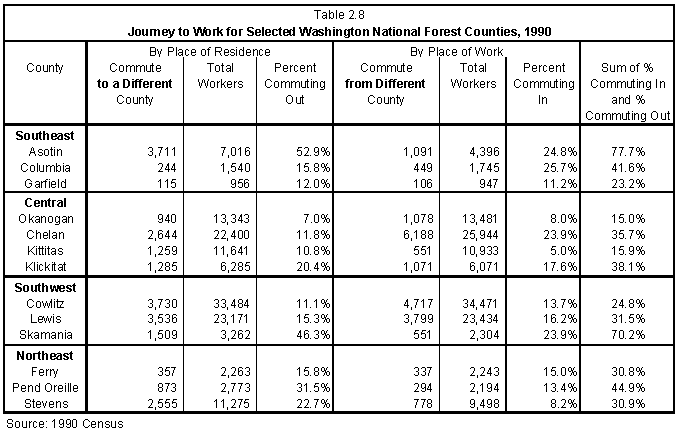
It is always
possible, of course, that some areas are so isolated geographically that
residents cannot practically commute to either work or shop. In such isolated
areas, the local economic opportunities might accurately represent all
the opportunities available to residents. In that setting, it may be appropriate
to focus the economic impact analysis solely on that small town.
One way to identify such isolated small towns is to draw a circle around them that represents a reasonable commute, say 30 to 60 minutes one-way. If a larger city of, say, 10,000 or more is located within that circle, that small town could be said not to be isolated but, instead, be seen as part of the larger city's regional economy. For small towns on interstate highways or other multi-lane highways, that distance could be approximated by 50 miles. For small towns on smaller highways, 35 miles could be used. That was the approach taken in the ICBEMP analysis of small communities. (3)
Our interest here is in small isolated towns that depend on forest products manufacturing for a substantial percentage of their employment and income. The Forest Service has defined such "timber dependence" as towns that rely on wood products for 10 percent or more of employment. (4) Because that definition left out many towns considered by political leaders to be "timber dependent," Congress ordered the ICBEMP to take another look at all the small towns that rely on timber processing for employment. That re-analysis focused on "specialization" rather than "dependence." If a town had a larger percentage of its employment in wood products than the average across the entire nation, it was labeled as "specialized" in timber production regardless of how small a percentage of the total workforce was actually employed in wood products.
Table 2.9 lists the isolated timber "dependent" and timber "specialized" towns in eastern Washington. These isolated "timber towns" are found exclusively along Washington's northeast tier: Okanogan, Stevens, Ferry, and Pend Oreille Counties. Geographically this makes sense. The towns in the three counties in the northeastern corner of the state are located in river valleys running north to south with no major highway linking them to the closest metropolitan area, Spokane. Okanogan County hugs the Canadian border on the north and the Cascades on the west and is also isolated from the state's metropolitan areas, 130 miles from the nearest interstate highway.
This is not to say that each of these counties is entirely isolated or primarily dependent upon timber. Okanogan County, like Chelan County, is classified as specialized in recreation within the USDA classification of nonmetropolitan counties. In the northeast there is considerable commuting between Spokane and the counties neighboring to the north. The 1990 Census showed almost 2,200 workers commuting from Stevens County to Spokane to work. Over 500 workers in Pend Oreille County commuted to Spokane. Meanwhile over 400 Spokane residents commuted to Stevens and 200 to Pend Oreille to work. Hundreds also commute between Ferry and Stevens. In addition, Pend Oreille shares hundreds of workers across the Idaho border with Boundary County.
Census data
only reports on the journey to work of residents of towns larger than 2,500.
Only Omak and Colville of the isolated "timber" towns met that criterion
in the 1990 Census. In Omak, only about half of the town's workers worked
in the town itself. The other half commuted to jobs elsewhere. In Colville
about 28 percent of the town's residents commuted outside the city to jobs.
(5) The Census does not report on those who live outside the
town who commute into the town to work. But the data on out-commuting reinforces
the warning that even in isolated towns, it is not safe to treat the individual
town as an economy onto itself. A regional analysis rather than a town-based
analysis is needed. This is obvious in towns like Clarkston, Vancouver,
Camas, Cashmere, or Wapato that are within relatively short drives of larger
cities. For these towns the percentage of residents commuting out to work
is very high 62, 58, 72, 62, and 52 percent respectively. But even "isolated"
"mill" towns like White Swan on the Yakima Indian Reservation had 71 percent
of residents commuting out of town to work. Even relatively large towns
such as Wenatchee and Yakima had a third of their residents commuting out
to work. It is rarely safe to analyze a town as if it were a relatively
self-sufficient economy.
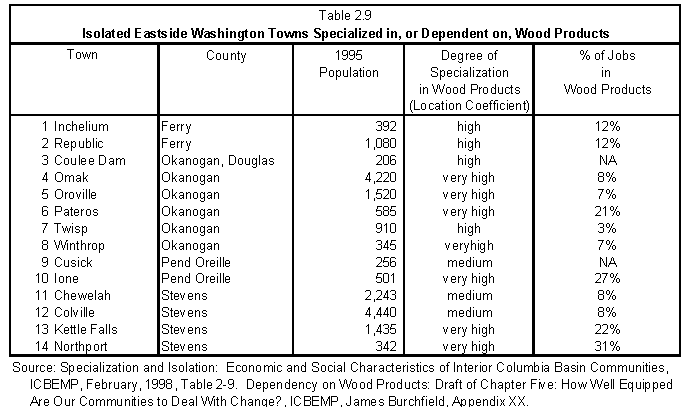
All of these isolated "timber" towns identified in Table 2.9 have not been in dire economic difficulties as a result of the dramatic fall down in National Forest harvests since 1988, (See Tables 2.5 and 2.6). Only two of these towns actually lost population, Ione and Coulee Dam. Between the two, the loss was less than a hundred people. This whole set of isolated "timber" towns gained almost 2,000 people or about 12 percent during the 1990s despite the declines in National Forest timber harvests. Several, such as Winthrop, Cusick, Kettle Falls, and Chewelah, saw 20 to 30 percent increases in their populations. See Table 2.10. Clearly even these isolated "timber" towns were showing considerable economic vitality despite the declines in federal timber harvests. This suggests that many of them are not primarily dependent upon federal timber harvests for their economic well-being. As mentioned above, Okanogan County has been classified as a recreation county by the Economic Research Service of the USDA. The towns of Twisp and Winthrop have heavy recreation and landscape amenity aspects to their economies. Cusick and Chewelah, at the southern ends of Pend Oreille and Stevens Counties, are within commuting distance of Spokane and have experienced "spill-over" effects associated with that dynamic metropolitan economy.
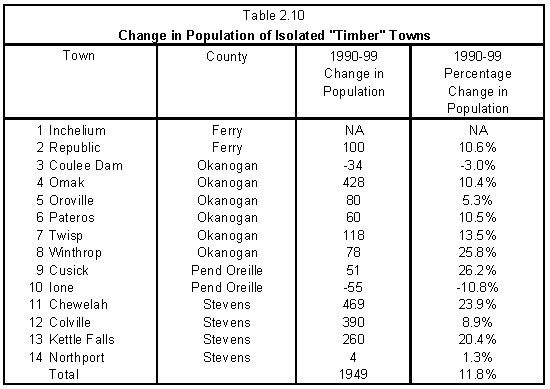
The recent ICBEMP Supplemental Draft EIS classified the northeastern tier of counties that we have identified as having some isolated, timber-dependent communities that have either "very low" or "low" levels of isolation and specialization. That characterization was not based on countywide analysis but, rather, on economic regions immediately around the potentially isolated towns. (6)
Since all of these isolated "timber" towns are located in the four eastern counties along Washington's northern tier, a review of the experience of those counties during these dramatic declines in federal timber harvests is also relevant. During the period when federal harvests fell to a small fraction of what they had once been, all of these "isolated" "timber" counties experienced significant net in-migration. Thousands of people voting with their feet did not find these counties an unattractive economic environment into which to relocate. Total populations rose about 25 percent in Pend Oreille County and 15 percent in Okanogan County. The other counties' population gains were between these two. The average increase during the 1990s was about 20 percent. See Table 2.11.
All of the isolated "timber" towns identified in Table 2.9 are located in Pend Oreille, Stevens, Ferry, and Okanogan Counties. As mentioned earlier, some of the mill towns in the southern portion of the three northeastern counties are within commuting distance of Spokane. If this is ignored and we treat all of the forest products employment in these counties as "isolated", then about 30 percent of forest products employment on Washington's eastside is located in these "isolated" areas. Put the other way around, 70 percent of forest products employment is located within commuting distance of a metropolitan area or a town of at least 10,000 people. This is important in judging the range of economic opportunities open to forest industry workers who may be affected by reduced federal harvests. A sizable majority of forest products workers live within reach of a number of very diverse and growing economies. Even the 30 percent living in these four "isolated" counties were part of economies that collectively added over 10,000 new jobs while federal timber harvests were declining and forest products employment was shrinking by 500.
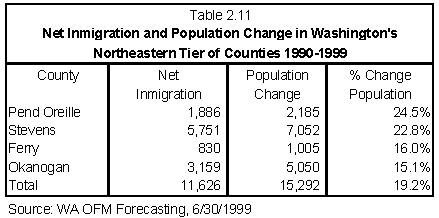
The total number of jobs on the eastern Washington in 1997 was 692,000. Total forest products employment in 1998 was about 9,900. (7) The Forest Service has estimated that about 650 of these forest products jobs are associated with federal harvests. (8) The eastern Washington economies added about 107,000 new jobs between 1990 and 1997, an average of 13,400 per year. For the majority of forest products workers, clearly there were an incredible variety and steadily expanding set of employment opportunities despite the dramatic declines in National Forest timber harvests.
E. National Forest Timber Harvests and Unemployment
i. Declining Federal Harvests and Employment LevelsIn the preceding discussion we have pointed out that the dramatic decline in National Forest timber harvests did not result in a similar dramatic decline in employment opportunities. Quite the opposite, while federal timber harvests tumbled to a fraction of their earlier levels, literally hundreds of thousands of new jobs were created across the state, nearly170,000 of them in the "timber dependent" counties we have been focusing upon. See Table 2.12.
A comparison
of the percentage growth in jobs at the state level with the percentage
growth in jobs in these "timber dependent" counties while federal timber
harvests were collapsing shows that almost all of these counties shared
in the expansion in employment opportunities.
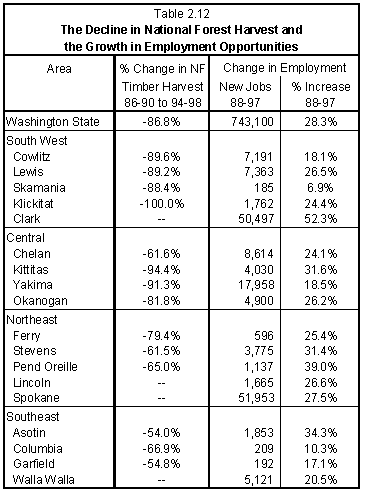
Sources: US BEA REIS, Washington Department of Natural Resources
Of the three counties with slow employment growth in Table 2.12, we have already pointed out that Columbia and Garfield Counties had little or no forest products employment and that the slow growth of jobs in those counties was tied to their rural, very low density populations, and reliance on agriculture. The only county with substantial forest products reliance that had very low employment growth was Skamania which in 1988 had almost a third of all its jobs directly in forest products and saw employment grow only about 7 percent even though population grew 23 percent. This is not due to an influx of retirees. While total population increased by 1,800, the population over 65 increased by only 100. Skamania's population lives almost exclusively along the Columbia River within commuting distance of Hood River, The Dalles, and the Vancouver area. The job growth that supports this growing population is located outside of Skamania County. Since the early 1980s, real earnings from jobs in Skamania County itself have been flat, but the earnings brought into Skamania County from employment in other counties has grown steadily until the earnings for those "outside" jobs now exceed the earnings from jobs in Skamania County itself. In that sense, the apparent slow growth in employment is an artifact of focusing on too small a geographic area to include all the sources of employment that support the local population. That is the disadvantage of looking at individual counties as if they were self-sufficient economies when in fact they often are economically linked strongly to surrounding areas.
It seems unlikely that one can attribute unemployment in those counties to falling federal timber harvests given the relatively rapid growth of employment opportunities in these "timber dependent" counties. Yet it is true that many of these counties had unemployment rates significantly above the statewide average. This important feature of these economies is worth additional investigation.
ii. Declining Federal Harvests and UnemploymentThe unemployment rates in many of eastern Washington's National Forest counties are quite high, well above the statewide average. In the three rural northeast counties, for instance, the unemployment rates in 1998 were over twice the statewide average. The same is true in thethree contiguous southwest counties. See the Table 2.13.
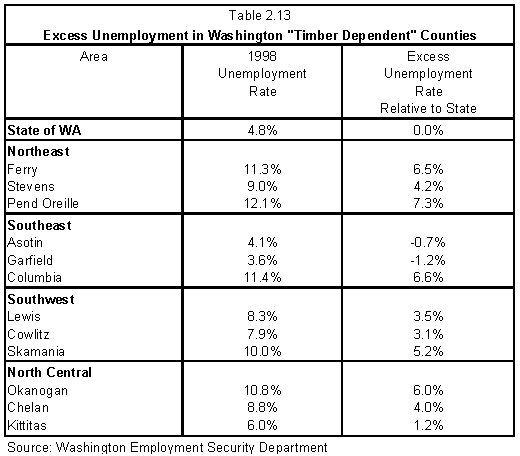
Because many of these high unemployment counties have significant National Forest lands and/or forest products industries, some have asserted that the excess unemployment is tied to the declines in timber harvests on federal lands during the 1990s. One way to test this claim is to compare the current unemployment rates in these counties with the unemployment rates back in 1988 when National Forest and total timber harvests were at their peak levels. Given the peak flow of timber from the National Forests to the mills in that year, it would be difficult to attribute any local unemployment in that year to inadequate timber harvests on National Forest lands.
In all but three of the counties included in Table 2.13, unemployment rates declined between 1988 and 1998. Those that increased did so by less than half a percentage point. These improvements in employment took place despite the fact that total National Forest timber harvest in Washington in 1988 was 1,486 mmbf, over thirteen times as high as the 1998 National Forest timber harvest of 111 mmbf. For the high unemployment counties listed in Table 2.13, federal harvests were almost eleven times as high in 1988 as they were in 1998. Despite the loss of over 90 percent of the federal harvest, unemployment was stable or declined.
The excess
unemployment rates relative to the state average in these counties in 1988
were also similar to the excess unemployment rates in 1998. That is, even
during periods of peak timber harvest, the unemployment rates in these
counties were relatively high. The existence of excess unemployment in
these counties even in the year of peak harvest is shown in Table 2.14.
Although the excess unemployment was somewhat higher in 1998 than in 1988
in the northeast counties, in the north central and southeast, unemployment
was either about the same or lower. In the southwest, the county with the
largest federal harvests and one of the greatest harvest declines, Skamania,
saw excess unemployment decline dramatically, not increase.
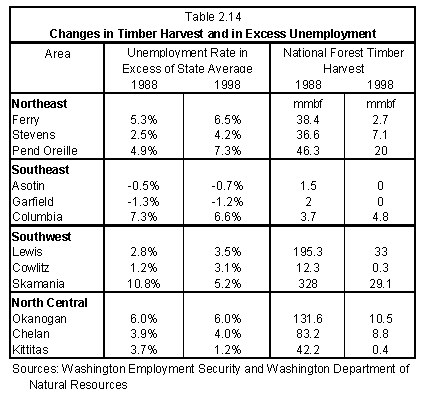
The relatively constant rate of excess unemployment, despite dramatically different National Forest timber harvests can also be seen by following unemployment rates and timber harvests over time. Figures 2.3 through 2.5 show this for several regions. Figure 2.3 focuses on the five central Washington counties that received timber from the Okanogan, Wenatchee, and Gifford Pinchot National Forests. Figure 2.4 shows this for the three rural northeast counties that rely upon the Colville National Forest. Figure 2.5 shows it for three rural southwest counties that rely on the Gifford Pinchot. In all three cases, despite dramatic declines in National Forest harvests between 1987 and 1997, the unemployment rate in excess of the state average fluctuated a bit but remained relatively constant or, in the case of Skamania, declined dramatically. High unemployment in most of these counties characterized both high and low National Forest timber harvests. Clearly, the level of National Forest timber harvests is not what is driving the excess unemployment rates.
If declining timber harvests from public lands were not responsible for the relatively high unemployment rates in these nonmetropolitan counties, the question remains, what is? Part of the answer is the local economy's over-reliance on one or two industries, in particular, wood products manufacturing and mining. As the percentage of a nonmetropolitan county's total earnings that flow from manufacturing and mining increases, the excess unemployment rate tends to rise. This pattern is depicted for Washington's nonmetropolitan counties in Figure 2.6. Overly specialized economies tend to be more unstable as employment and income fluctuate with seasonal conditions and national and international market forces. The instability in employment in these industries is partially compensated for by the relatively high wages paid in industries such as forest products and mining. Earnings in these industries may be unstable, but they are above average, so that workers over the relatively long run are not disadvantaged. Those relatively high wages have another impact. When workers are laid off, they tend not to leave the area nor do they necessarily seek alternative permanent employment within the local economy. Instead, they wait for the industries to recover, so they can be hired back. The result is that unemployment rates in the area can remain unusually high.
Unfortunately,
a substantial part of the reductions in employment in wood products and
mining over the last two decades have been permanent, not tied to temporary
changes in market conditions. Wood products and mining are mature industries
to which labor saving technological change has had a long time to adapt.
As a result, the labor requirements per unit of output have declined substantially.
For instance, a significantly smaller workforce was able to handle the
peak levels of harvest in 1988 compared to the previous harvest peak in
1978. Although total timber harvests in Washington in 1988 were almost
1,800 mmbf higher than in 1978, employment was 12,300 lower.
As a result, even with peak levels of harvest in 1988, unemployment rates
in "timber dependent" communities were high. Increased timber harvests
do not necessarily mean increased employment relative to historical levels.
Because of that fact, most of the lost timber industry jobs will not be
recovered. It may take some time, however, for local employment patterns
to completely adjust to the permanent loss of these jobs.

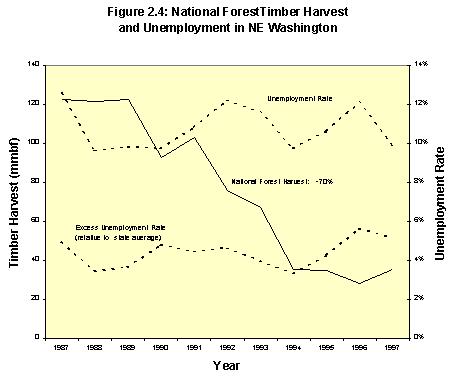
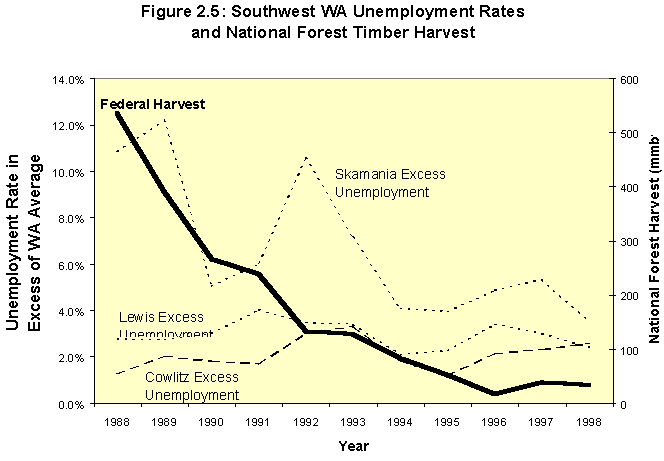

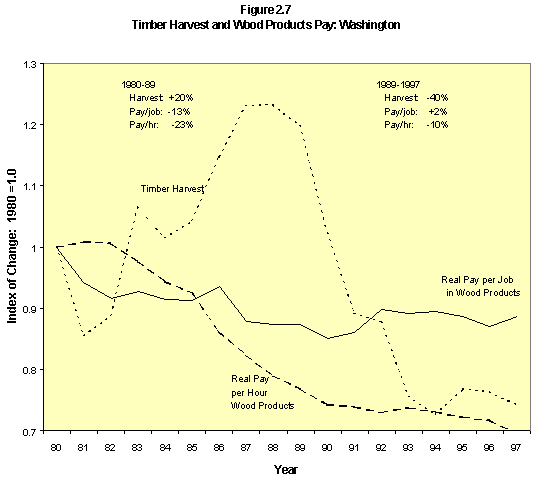
F. National Forest Timber Harvests and Average Real Pay and Income
In addition to concerns about the impact of reduced federal timber harvests on employment opportunities, there is also concern about the impacts of a reduced forest products industry on average pay and income, especially in nonmetropolitan areas.
It is important to distinguish between various measures of the average income being received by individuals and families. Average income ("per capita income") accounts for all sources of income, wages and salaries along with income from investments (dividends, rent, and interest), income from retirement programs (Social Security, Medicare reimbursements, and other pension programs), and other government payments. Average income is the result of averaging across all residents, adults and children, workers and retirees. Average pay takes into account only wage and salary income and the income of self-employed proprietors. It is averaged across only active workers. Annual pay per job focuses on each employment opportunity, not on the individual worker. A worker may hold more than one job during the year (seasonal work) and/or hold more than one job at any given time (part-time work). Annual pay per job will understate the average pay received by a worker who holds more than one job during the year. We use annual pay per job despite these drawbacks because it is easily calculated from available data.
It is often assumed that because the forest products sectors pay relatively high wages, communities that have relatively large concentrations of these jobs will have higher average incomes. In eastern and southwestern Washington that does not appear to be the case. As the percentage of local jobs in the forest products sectors increases, there is a slight depression in average income. (9) This was the pattern back in 1988 when timber supply constraints were not evident and harvests reached peak levels. The failure of specialization in wood products to boost average income is not unique to eastern Washington. The same pattern holds for the whole of the four-state Interior Columbia River Basin. (10) Research in the southeastern United States has also found that specializing in wood products does not boost average incomes. (11)
In Tables 2.4 through 2.7, we saw that average real income rose in most regions and counties during the 1990s despite the decline in National Forest timber harvests. That was not always the case when worker well-being is measured in terms of annual pay per job. Especially if one goes back to the late 1970s, in most nonmetropolitan counties average real pay per job has declined. This downward pressure on average pay has often been blamed on the loss of high paying jobs such as those in the forest products industry and their replacement by low paying jobs in the services-producing sectors. It is then a relatively small step to blame the decline in forest products jobs to reduced access to National Forest timber. This, however, confuses two quite different sets of events. Many forest product jobs were lost during the 1980s when National Forest timber harvests were rising toward the peak levels of 1988. Those job losses were associated with the restructuring of the forest products industry, especially the deployment of labor saving technologies, not reduced harvests. Furthermore, it was not primarily job loss in industries like forest products that explains the declining real annual pay. It was declining real pay in almost all jobs including those in forest products jobs that explains the fall in average real pay. If no forest products jobs had been lost, most of the decline in average pay would have taken place anyway because of the downward pressure on wages, including downward pressure in forest products.
Declining timber harvests cannot be linked to most of the decline in average pay simply because most of the decline in pay took place during a period of rising timber harvests. During the period when total harvests, including federal timber harvests, did decline, average annual pay either stabilized or increased. See Figure 2.7.
It needs to be pointed out that the early 1980s was a period of recession and, even, in the forest products industry, a depression. Because of that, much of the growth in federal timber harvests was simply due to a recovery from a low point associated with reduced demand for wood products and a movement back to peak levels of production. It is still true that as the industry recovered to peak levels of production, real pay per hour and pay per job in wood products declined significantly. During this period, mill owners were successful in imposing significant pay reductions on workers. (12) The increased levels of National Forest timber harvests neither supported higher wages for wood products workers nor higher wages for other workers.
If we look at individual "timber" counties in eastern and southwestern Washington and contrast what happened to average pay in all jobs during the 1980s when federal harvests were rising to peak levels with what happened to average pay during the 1990s when federal timber harvests were plummeting, there is a general pattern that does not support the assumption that rising federal timber harvests support higher pay and falling federal harvests undermine pay levels. If, for instance, we look at the regional groupings of counties that we have been focusing upon, the general pattern is that between 1980 and 1988 federal harvests rose significantly while average pay declined significantly. During the 1988 to 1997 period, federal timber harvests declined dramatically while average pay rose modestly. For some counties, average real pay continued to decline during the 1990s but the decline was always much smaller than it was during the period of rising harvests in the 1980s. See Table 2.15.
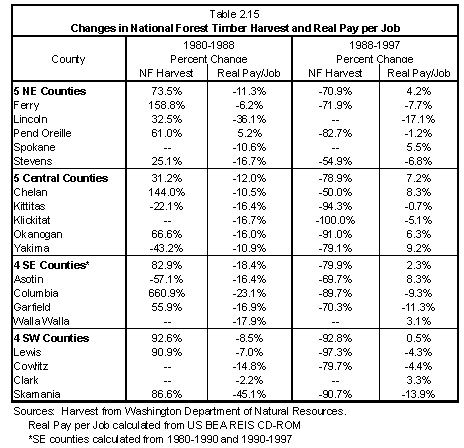
Again, it is important to realize that in the 1980s we are measuring these changes from a recession year to a year of peak timber harvest and in the 1990s we are largely measuring a period of continuous economic expansion. One would expect the recession and slow growth in the early 1980s to put downward pressure on pay and would expect the ongoing expansion in the 1990s to cause upward pressure on pay. The point of comparing changes in federal harvests with changes in average pay is not to suggest that rising federal harvests cause falling real pay or vice versa. The point is simply to underline the fact that we cannot simply assume that increased timber harvests increase the number of high paid jobs and boost average pay. The connection between timber harvests and average pay as well as the connection between the distribution of jobs across industries and average pay is much more complicated than the public discussion of the Washington economy usually suggests.
If one sets aside the clearly insupportable assumption that declining access to federal timber was the cause of the declines in average pay during the 1980s, there is still the possibility that declining wood products employment, caused by both weak demand for wood products and the adoption of labor-saving technology, triggered an overall decline in average pay. The intuitive idea is that wood products jobs were relatively high paid jobs and their loss simply pulled the average pay down. The evidence provided above, that pay in wood products was also tumbling, provides an alternative explanation. It was not the loss of high paid jobs but the decline in pay for both high and low paid workers that caused overall pay to deteriorate. That is an important distinction. In one case, the shift of workers from one type of work to another is seen as causing the problem. In the other case, it is downward pressure on almost everyone's pay that is causing the problem, not a shift of workers from one industry to another.
These two competing hypotheses can be tested by calculating what would have happened to average pay if workers had not been shifting out of wood products and into other industries during the 1980s. That is, if the industrial structure of employment had been frozen where it was in the 1970s, so there were no workers shifting from high wage to low wage jobs, but the pay changes that actually took place in the 1980s are allowed to proceed, what would have happened to average pay? Alternatively, one could calculate what would have happened to average pay if pay were frozen at mid-1970s levels, but workers are shifted among industries just as they actually did shift in the 1980s. The latter would give us a measure for how important the shift of workers from high paid to lower paid jobs was in explaining the decline in average pay.
We have done this for the counties that the Forest Service identified as timber dependent counties in the Pacific Northwest states including those clustered in northern California, western and eastern Washington, northern Idaho, western Montana, as well as southwest Oregon. (13) Because wood products employment data is often not available for small timber dependent counties because of confidentiality restrictions, all goods-producing activities were used to represent the "high paid" jobs and all service-producing industries were used to represent the low paid jobs. Between 1976 and 1996 real annual earnings per job in these timber-dependent counties fell by $6,500. However, if the share of employment in the goods-producing sector had been frozen at its 1976 level, 95 percent of this decline would have taken place anyway. That is because real annual pay per job in goods production plummeted $10,400 per year, while it "only" fell $3,900 in services. In 1976 the goods sector paid $8,000 per year more and the service sector paid $4,000 per year less than the average. But by 1996, pay was only $3,000 above the average in the goods sector and only $1,000 below the average in services. It was becoming harder to distinguish the "good" jobs from the "lousy" jobs. In explaining the overall decline in average pay, clearly the focus has to be on the fall in pay in the high paid sectors like forest products as well as the decline in pay across almost all sectors, not the shift in employment shares from forest products and other goods production to other sectors.
Even if one cannot blame declines in federal timber harvests for low or declining pay and income in the small cities and rural areas of eastern and southwestern Washington, it remains true that average pay and income in these areas is well below both the state and national levels. That has led most of these counties to be defined as "distressed areas" by the Washington State government. That classification suggests that something, whether or not it was declining federal harvests, is harming the regional economy. This may well not be the case for many of these counties. There is ongoing evidence of economic vitality: growing populations, expanding employment opportunities, and rising average real income. The problem may be the comparison that is usually made that uses the Washington State or the national average as the reference point.
The state average as well as the national average are heavily influenced by very large cities. In Washington, the Puget Sound area and its high incomes tend to dominate state statistics. Across the nation, half of the nation's population lives in 32 cities that have a population of 1.4 million or more. As a result, average income in the nation tends to reflect that of people living in quite large cities. As city size increases, so does average income and pay. Small cities and rural areas across the nation have lower pay and income at least partially because of lower cost of living (especially housing) and fewer urban congestion problems. (14) If Washington's smaller cities (outside of the Seattle area) and rural areas are compared to similarly sized cities and rural areas across the nation, Washington is doing about as well as the nation: Between 1993 and 1997 average income in Washington's nonmetropolitan areas was about 6 percent above the US nonmetropolitan areas while the average income in Washington's cities sized 150,000 to 400,000 (all of Washington's metropolitan areas other than Seattle) had average incomes about 3 percent below those sized cities elsewhere in the nation. The "other Washington" is doing about as well as similar places across the nation in terms of average pay and income. In general, those who choose to pursue small city and rural lifestyles will not be able to receive big city pay and income.
G. Federal Timber Harvests and County Government Revenues
Because local governments cannot levy taxes on federal land and the economic activity that takes place on that land, Congress has authorized federal payments to local governments "in lieu of taxes." Under current federal policy, a 25 percent share of the revenue the Forest Service receives from the sale of federal timber is paid to local governments. In addition, there is a minimum payment that the federal government makes each year that is tied to the number of acres of National Forest land in the county. These two payments are not additive. The latter payment per acre is intended to assure some federal payment to local governments even if very little timber is harvested. These federal payments to local governments go to support schools and roads.
As National Forest timber harvests have declined dramatically in the 1990s, so, too, have these payments to local governments. Thus, in addition to reducing employment and income opportunities, declining federal harvests are also blamed for undermining the ability of communities to provide for basic public services. There has been enough concern about this impact of declining federal harvests to generate a variety of proposals for new federal legislation to stabilize the support that National Forests provide to local governments in the jurisdictions in which they are located. Some proposals seek to "decouple" the federal payments from commercial harvest and set the payments at historical levels. Timber interests object to this approach because it reduces the incentives that local governments have to support ongoing commercial development of the National Forests. They would prefer legislation that forces the Forest Service to increase harvests and return the payments to counties to previous levels. During the spring of 2000, a bipartisan proposal to raise National Forest payments to local governments to the average level of the years of peak harvests in the late 1980s appeared on the verge of winning congressional approval. That would reverse the declines in payments to local governments that took place during the 1990s and dramatically increase the current levels of those payments.
There is no doubt that the National Forest payments to counties have declined during the 1990s. Statewide, these payments have declined by almost $12 million between 1991 and 1998, or about 28 percent. It is important to put this decline into the context of the growth in overall county government revenues. During this same time period, total county government revenues grew $2.1 billion or 103 percent statewide. In that sense, the decline in federal payments to counties did not cause an absolute reduction in the dollars local governments had available to support public services. The impact of the declining federal payments was to reduce the rate at which the available county revenues expanded. All counties, of course, did not have the same experience as the state as a whole. National Forest timber harvests are concentrated in certain counties and a subset of those counties are far more dependent on federal payments than are, for instance, the large metropolitan areas.
If one focuses on those counties in southwestern and eastern Washington for which federal timber harvests have been especially important, we can get a more accurate picture of the local impacts of the declining federal payments to counties. Table 2.16 compares the decline in National Forest payments to counties with the expansion in total county government revenues during the 1990s. (15) These are expressed in dollar terms as well as in terms of percentage increase. The impact of declining National Forest payments to counties is expressed in terms of how much more county revenues would have increased if those declines had not taken place.
For the state
as a whole, the decline in county government revenues represented by the
National Forest payments was very small. Avoiding that decline would have
raised county government revenues less than one percent on top of the 103
percent increase actually experienced. For most of the "timber" counties
we have focused on, the additional growth that constant National Forest
payments would have provided was also quite small, 0 to 2 percent for 12
of the 18 counties. For all but one of the others, the increase would have
been 6 percent or less on top of quite large overall increases in county
government revenues. The exception is Skamania County where total county
government revenues hardly grew at all but where, if the federal payments
had not declined, overall all revenues would have grown by almost 25 percent.
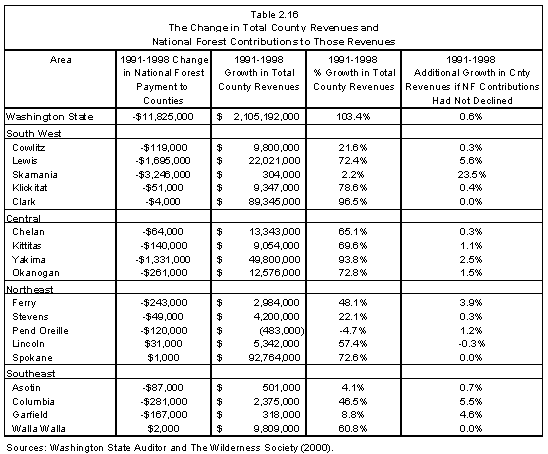
In several other counties, because county government revenues grew very slowly, the increment that could have been contributed by the National Forest payments, if they had not declined, would have been significant. Pend Oreille, Asotin, and Garfield Counties fall into this category. The problem was not so much the decline in National Forest payments as it was the failure of these counties to share in the rapid growth in county government revenues that the rest of the counties experienced. As discussed earlier, Garfield County is not a "timber dependent" county, since it has little or no forest products employment. It is a rural county with a significant agricultural sector that has lagged behind the rest of the state in terms of population, job, and income growth.
The other three counties, Skamania, Asotin, and Pend Oreille, have a common characteristic: They all have a large portion of their workforce that commutes out of the county to work. The percentage of net earnings that residents derive from work outside the county were 54, 43, and 12 percent for Skamania, Asotin, and Pend Oreille, respectively. This means that a significant part of the business facilities and economic activity that support these residents is not available for their county of residence to tax. This may have limited the ability of the county to expand its revenues to maintain public services. In this setting, because of the stagnant tax base, the contribution that National Forest payments could have made to support local governments would appear to be significant. It is important to understand, however, that the problem was not that the National Forest payments were large, but that the county tax base had stagnated for reasons not associated with declining federal timber harvests. For most of these "timber counties," the tax base and total county revenues continued to grow significantly and the decline in the contribution made by the National Forest payments was readily absorbed by that overall growth.
H. National Forest Management and Public Lands Grazing
Timber harvest is not the only commercial use of National Forest lands. The National Forests as well as Bureau of Land Management lands in Washington are also leased to livestock operations for forage. Neither administrative action to limit the extension of roads nor Congressional action to protect roadless areas as Wilderness would affect livestock grazing. The current levels of livestock grazing are supported by the existing access roads. Livestock grazing is also allowed in designated Wilderness. In that sense, banning additional roads in roadless areas or Wilderness classification would not affect the level of livestock grazing. Given the concern, however, that any additional protection granted these wildlands would encourage restrictions on livestock grazing, it may be relevant to explore the relative economic importance of federal lands livestock grazing in eastern and southwestern Washington.
A reasonable approximation of the relative importance of federal livestock forage can be obtained by considering three factors:
i. How important is agriculture as a source of jobs and income?The last point assumes that federal forage is just one source of forage for livestock in Washington. Most livestock producers do not have access to federal forage. No livestock producer in Washington can rely entirely on federal forage. Livestock producers mix various sources of livestock feed depending upon the relative cost and availability of each: owned pasture and grazing lands, private leased grazing, self-produced hay and feed grains, purchased hay and feed grains, purchased protein supplements, federal leased grazing, etc.ii. What part of agricultural operations are livestock operations?
iii. What percentage of the feed requirements for livestock operations comes from federal livestock grazing?
The factors
listed above in i. through iii. can be multiplied together to obtain an
estimate of the direct economic contribution federal forage makes to the
local economy. Previous analysis by the author calculated this using data
available in 1996, before the 1997 Census of Agriculture. Given that agricultural
patterns change only slowly, that analysis still provides a good approximation
of the relative importance of federal land grazing in eastern Washington
counties. These estimates are provided in Table 2.17.
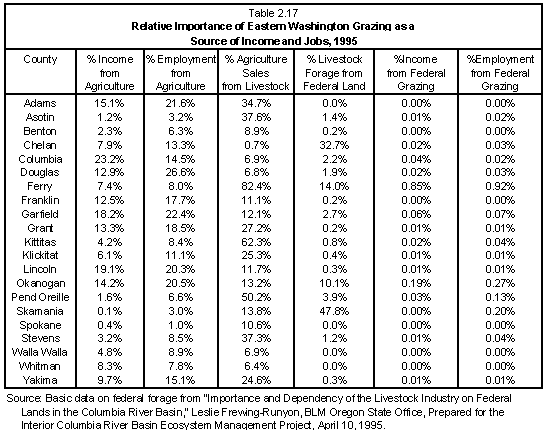
Agriculture is a source of ten percent or more of income and/or jobs in half of the eastern Washington counties. Livestock production represents ten percent or more of agriculture production in eight of those "agriculturally dependent" counties. That reduces our focus to counties where livestock production is the source of 1 percent or more of income and/or jobs (10 percent times 10 percent). The vast majority of these "livestock dependent" counties, however, do not rely upon federal forage for a substantial part of their livestock feed. Using 10 percent of total feed coming from federal forage as cutoff for "federal forage dependent," would mean that a county that derived as little as one-tenth of one percent of its income or jobs from federal forage would be labeled "federal forage dependent," i.e. 0.1 X 0.1 X 0.1 = 0.001. Only one "livestock dependent" county is also "federal forage dependent" under these criteria, namely Okanogan County. With 14 percent of income and 21 percent of employment directly in agriculture and 13 percent of agriculture production being livestock and 10 percent of livestock feed coming from federal forage, about 0.2 percent of income and 0.3 percent of employment in Okanogan County is directly associated with federal grazing. Ferry County was more dependent on federal forage for economic activity than Okanogan because 82 percent of its agricultural production was in livestock and 14 percent of the livestock feed came from federal forage. As a result, even though agriculture represents less than 8 percent of its overall economy, the percentage of total income and employment directly tied to federal forage approaches one percent (0.9 percent). No other eastern Washington county approaches even this one percent maximum reliance on federal forage because where federal forage is important, grazing often is not; where agriculture is important, often livestock is not; etc. The next most "dependent" county on federal forage is Skamania with about two-tenths of one percent of employment directly tied to federal forage.
Roadless area and Wilderness protection do not prohibit federal grazing. For that reason, such protection is unlikely to affect local economies through any impact on public land grazing. In any case, federal grazing plays such a small role in all eastern Washington county economies that changes in federal grazing policy would not have significant impacts on county economies in any case. The ICBEMP Supplemental Draft EIS confirms this judgment. It estimates that approximately 30 jobs in all of the eastern Washington are directly associated with grazing on Forest Service and BLM lands. (16)
I. Conclusions on the Impact of Large Declines in National Forest Timber Harvests on Local Economic Vitality in Eastern and Southwestern Washington
The reason we have spent so much time analyzing the economic impact of the large declines in National Forest timber harvests that have taken place since the late 1980s is that that experience represents an impact that was as much as 100 times larger than the impact that can be expected from setting all inventoried roadless areas off limits to commercial timber harvests. See Table 2.1. If the impacts of the dramatic fall down in federal timber harvests during the 1990s were successfully coped with by Washington's communities, we can be certain that they will have no significant problems coping with the timber harvest implications of protecting all of Washington's remaining roadless areas.
What were the impacts of federal timber harvests declining by 90 percent or 871 million board feet in the eastern and southwest Washington counties we have focused on between 1988 and 1998? Let us simply list the conclusions from this chapter:
a. Statewide, despite a 93 percent decline in National Forest timber harvests between 1988 and 1998 and the loss of 7,300 forest products jobs, the number employed outside of forest products expanded by 726,000. Total real income expanded by almost 50 percent, population by 23 percent and total employed persons by 33 percent between 1988 and 1998.b. Similar economic vitality was also found in the largely nonmetropolitan counties adjacent to National Forest lands in eastern and southwestern Washington. Although several thousand forest products jobs were lost, over a hundred thousand new jobs were added outside that sector. The counties adjacent to the National Forests were not driven into economic depression as a result of 70 to 90 percent declines in federal harvests. Instead, average real income, employment, and population expanded significantly.
c. Even within the relatively isolated areas such as the northeastern tier of counties there was considerable economic vitality despite the declines in federal timber harvests. Only two isolated "timber dependent" towns lost population. In general all areas gained population at rates above the national average. Some of the isolated areas, such as Okanogan County did almost as well as the state's metropolitan areas despite the decline in federal harvests.
d. The relatively high unemployment rates in many of the eastern and southwestern Washington counties adjacent to National Forests cannot be attributed to the decline in federal harvests. Those counties had similar excess unemployment rates at the time of peak harvests in the late 1980s when timber supply constraints were obviously not limiting harvests. These excess unemployment rates did not rise as federal harvests fell dramatically from these peak levels.
e. The average real pay is low in eastern and southwestern Washington counties adjacent to National Forests. This low pay, however, is not the result of the decline in federal harvests. Average real pay plunged during the 1980s while federal harvests were rising to peak levels. While federal harvests fell in the 1990s, average pay stabilized or increased.
f. National Forest payments to local governments declined with federal harvests during the 1990s. This, however, did not cause an overall decline in the revenues available to local governments. Local and state economic vitality allowed local government revenues to rise significantly despite the decline in the National Forest contribution.
2. Employment covered by unemployment insurance actually increased significantly more than the 5,000 figure suggests. Covered employment increased by 6,300 during this time period.
3. Economic and Social Characteristics of Interior Columbia Basin Communities and an Estimation of Effects on Communities from the Alternatives of the Eastside and Upper Columbia River Basin Draft Environmental Impact Statements, Interior Columbia Basin Ecosystem Management Project, US Department of Agriculture, Forest Service, and US Department of Interior, Bureau of Land Management, February 1998, p. 12.
4. Dependent Mills and Communities," USFS Washington Office Memorandum (file designation 2400) from the Deputy Chief of the Forest Service, Lamar Beasley, to Mr. Don Knowles, staff assistant to the Subcommittee on Interior and Related Agencies, Appropriations Committee, US Senate.
5. 1990 Census of the Population, Social and Economic Characteristics, Washington, Table 198.
6. Interior Columbia Basin Supplemental Draft Environmental Impact Statement, Volume 1, page 202, Map 2-33, March 2000.
7. The total employment is taken from the REIS database; the forest products is taken from covered employment and increased by 14 percent, the amount by which REIS forest products exceeds covered forest products in the statewide data.
8. The ICBEMP SDEIS estimated that 403 jobs were associated with National Forest harvests in the E. WA, Yakima PAC, and E. WA Cascades areas (Table 4-44). To this we have added an estimate of the employment associated with harvests from the eastern Washington owl forests (20 mmbf on the Wenatchee and 3 mmbf on the Okanogan) and the Umatilla harvest in Washington (8 mmbf). These additional federal harvests were multiplied by an estimated 8 jobs per mmbf.
9. For each percentage point increase in the forest products employment, average income declines about $70. This relationship is weak, being significant only at the 90 percent level, not at the usual 95 or 99 percent level.
10. "An Assessment of Ecosystem Components in the Interior Columbia Basin…," Volume 4, p. 1810, USDA Forest Service, Pacific Northwest Research Station, PWN-GTR-405, June 1997.
11. Overdvest, C. and G.P. Green, 1995, "Forest Dependence and Community Well-being: A Segmented Market Approach," Society of Natural Resources 8:111-131.
12. See "Diverging Patterns: Labor in the Pacific Northwest Wood Products Industry," Marcus R. Widenor, Industrial Relations, 34(3):441-463, July 1995.
13. Timber dependency was defined as ten percent or more of county earnings originating in the lumber sector in 1990. Those counties have been identified by the US Forest Service (McGinnis et al., 1996). This section is based on the author's "Converting 'Good' to 'Lousy' Jobs? The Impact of Changes in Industrial Structure on Pay in the Inland West, The Pacific Northwest, and Montana," a paper presented at the 33rd Annual Pacific Northwest Regional Economic Conference, Boise, Idaho, May, 1999.
14. See "Are We Really Poor? Size of Place and Relative Pay and Income in the Small Cities and Nonmetropolitan Areas of the Pacific Northwest and Mountain West," by Richard N. Barrett and Thomas Michael Power, a paper presented at the 34th Annual Pacific Northwest Regional Economic Conference, Bellingham, WA, April 27-29, 2000. Available at www.cas.umt.edu/econ/wrkpap.htm.
15. The data on the changes in National Forest payments to counties is taken from "Schools, Counties, and Logs: Federal Lands Payment Programs in the Pacific Northwest," The Wilderness Society, January 2000, Pacific Northwest Regional Office, Seattle, WA. The source cited for the data is US Forest Service, "Payments to State from National Forest Receipts, County Summary," computer printouts, ASR-10-3, Washington, D.C., 1999. The county government revenues are taken from the Washington State Auditors website (www.sao.wa.gov/lgfp/).
16. Interior Columbia Basin Supplemental Draft Environmental Impact Statements, Volume 1, p. 158, Table 4-43, March 2000.